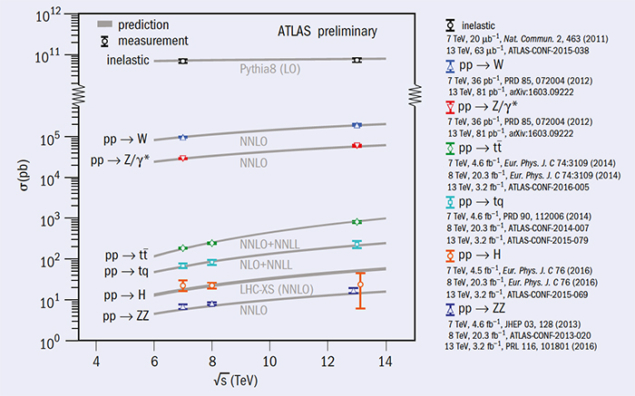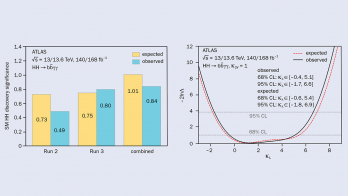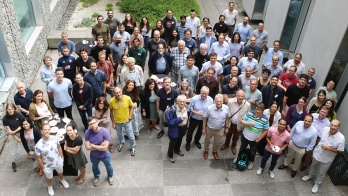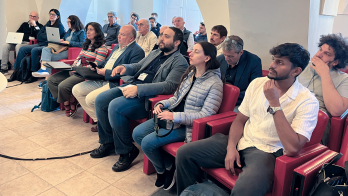
Image credit: ATLAS Collaboration.
At the heart of every LHC collision are the constituents of protons: the quarks and gluons, collectively known as partons. These partons can undergo hard-scattering processes, producing a plethora of final states ranging from the massless to the very massive, such as W and Z bosons or top-quark pairs. Understanding these production cross-sections and their evolution as a function of the centre-of-mass energy, √s, of the LHC are important components to understanding all of the measurements performed by ATLAS, including searches for new physics beyond the Standard Model.
Figure 1 illustrates some of the cross-section measurements made by ATLAS at √s = 7, 8 and 13 TeV. The new 13 TeV data collected in 2015 greatly extend the lever arm of the investigation of the √s evolution, with increased cross-sections for W and Z bosons and top-quark pairs by factors of approximately two and three, respectively, from their values at 8 TeV.
The final states observed from hard scattering tell a story of which partons participated in the collisions: e.g. top-quark production is related to the gluon composition of the proton, whereas Z-boson production provides insight into the quark sea, and W-boson production on the relationship between the valence quarks. These measurements are pieces of the proton puzzle, and because the √s evolution changes the range of the parton momentum fractions probed by the collisions, the 13 TeV data open up a new kinematic region of investigation.
Via hard scattering, one can also test the predictions of perturbative QCD – a key component of the Standard Model. Single and dibosons are currently predicted at next-to-next-to-leading order (NNLO), and top-quark pair production at NNLO plus next-to-next-to-leading log (NNLL). As √s increases, the mix of the hard-scattering processes changes, and the precision measurements become increasingly dependent on the knowledge of growing electroweak corrections currently available at NLO. With higher √s, rarer processes like Z-boson pair production (ZZ) become more accessible and open an enticing window onto potential new physics.
As is evident from figure 1, results match well with Standard Model expectations. Apart from a common beam-luminosity uncertainty, the measurements at 13 TeV have an experimental precision ranging from under 1% for Z bosons, to 3% for W bosons and top-quark pairs, to 14% for ZZ – the latter still being dominated by statistical uncertainties. However, measuring ratios of cross-sections can benefit from the cancellation of many experimental uncertainties. This is evident from the W+/W– cross-section ratio at 13 TeV, which has a total systematic uncertainty of less than 1%, rivalling the precision of the current predictions of parton-distribution functions but whose central value is consistently lower than predictions. Results such as those presented here will contribute significantly to the understanding of the large 13 TeV data set expected in the coming years.








